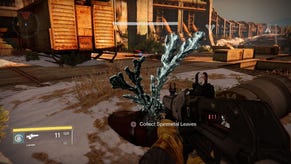Performance Analysis: Destiny on Xbox One
Does the 1080p upgrade mean full technical parity with PS4?
With our full Face-Off feature under way for this weekend, it's the Xbox One release of Destiny that poses the biggest questions. Having already seen Diablo 3 go from 900p to a full 1080p (albeit with some occasional frame-rate hits), we now have Bungie's sci-fi goliath attempting to pull off the very same technical wizardry. But given its ambitious, effects-heavy, open-world design, has matching the PS4's full-HD output required any downgrades elsewhere?
Bungie graphics engineer, Chris Tchou, said in a previous exchange with IGN: "This is the same resolution, the same frame-rate as PS4. We basically got together with Microsoft, and got a bunch of engineers here optimising and taking advantage of the system [Kinect] reserve - basically the extra GPU time that Microsoft gave us, and got it up to 1080p... the beta will run at 900p, so it's a little less. But rest assured by the time we ship we'll have it at 1080."
So our first port of call is checking the resolution itself; a pixel-count during both campaign and Crucible modes showing Bungie's promise has been kept. The Xbox One now delivers the maximum 1920x1080 frame-buffer allowed by its front-end settings, with each pixel revealing its own matching stair-step on vertical and horizontal edges. It's the real deal.
This feat is bolstered, and in certain respects hindered, by Destiny's use of FXAA post processing; an intelligent filter that targets the game's rough edges on both PS4 and Xbox One alike. Left in its raw state, a 1080p image would look crystal clear on a pixel-matched HDTV set, though without any extra processing, is at the mercy of pixel-crawl and noise artefacts. To address these lingering, high-contrast jaggies, a faint blur is introduced through this method - slightly sullying the hard work in producing Destiny's base image.
Outside of the 1600x900 internal resolution, Destiny's beta program on Xbox One showed few concessions when compared to the 1080p PS4 equivalent. Even so, image quality mattered here. Unlike the dark, top-down setup of Diablo 3, where a 44 per cent boost in pixel-rate didn't quite translate to a likewise leap in clarity, playing Destiny at 1080p makes a tangible difference. Tree leaves, grass tufts, netting, meshes, and even fabric textures render clearly at a distance now, while the upscaled 900p image of the Xbox One beta interpolated these elements - producing a fuzzier appearance from afar.
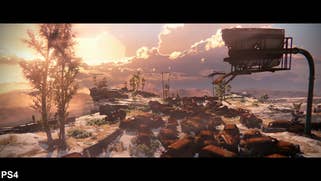
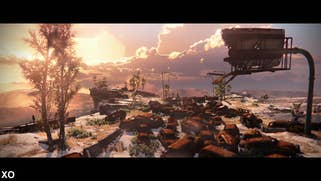
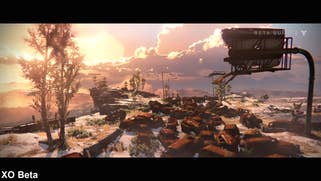


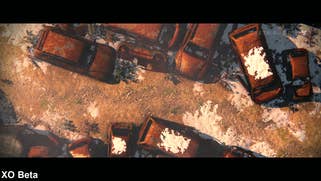


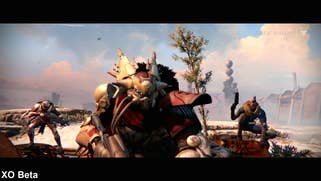

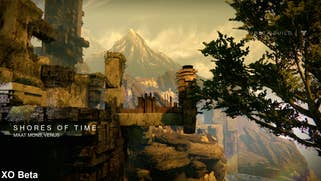

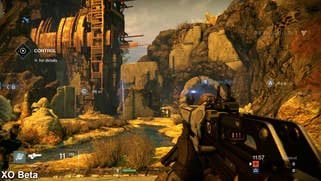

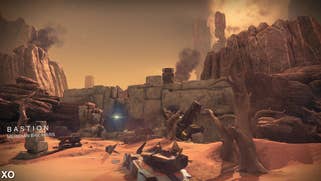
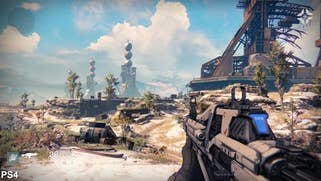

But such a boost to pixel count can't come cheap. Microsoft's June SDK may have unlocked resources previously assigned to Kinect, but this marks a considerable upgrade. However, in terms of in-game assets, nothing appears to have been pared back for Destiny's campaign or straight multiplayer modes. A charge through the initial Steppes areas, for example, shows draw distances and pop-in are like-for-like between the retail and beta builds on Xbox One, and even PS4. Even on the distant cliffs, shadow maps, geometry and enemy placements remain as they were. Bump-mapped rock textures also go untouched, but as a result of the resolution boost, now appear more defined even from a long range.
Effects-work and lighting also remain fixed in quality across the world, with a screen-space chromatic aberration effect now added to Xbox One's final build. This brings the Microsoft's platform up to speed with the PS4 release, where Bungie also ditches the flat HUD seen in the beta in favour of a curved design that matches Sony's console. It's a minor tweak, but one that completes the pixel-for-pixel likeness of many of our comparison shots between the two.
With no downgrades to world detail, even across the broadest maps, we turn to our performance analysis of the full retail Xbox One build. Compared with our beta playthrough, building up to the climatic The Last Array mission, it's clear a few frame-pacing issues linger. These are minor irregularities in the way frames are delivered, an issue that also manifests on PS4 - but significantly reduced since the beta launched.
Otherwise, Bungie's target 30fps is strictly adhered to, and with v-sync permanently engaged to boot. In fact, we only catch one hiccup to 28fps; a momentary blip while riding a Sparrow quickly across the wastelands. Based on its timing, this seems to have less to do with strains on the GPU, and is more about the engine's ability to stream the world, as made evident by the way it strikes at the same point as the beta release.
Having played the Crucible multiplayer mode at great length, searching for any whiff of a frame-rate drop, we're surprised to leave empty-handed here too. Dips from 30fps, in the conventional sense, simply aren't a factor for Xbox One running at 1080p; indeed, only the occasional frame-pacing stutter disrupts the game's flow. It's a surprising result given Diablo 3's performance hits after being patched on Xbox One; a less extravagant game in terms of scale, though admittedly one striving for the higher 60fps line.
Overall, the Xbox One version runs identically to its already impressive beta build, albeit with an added full-screen distortion effect, refreshed HUD design, and a crisp 1080p viewing window. With no performance penalty or pared-back visual settings in sight, first impressions suggest a release that very closely matches its PlayStation 4 counterpart in terms of both looks and performance - a state of affairs we're looking to fully confirm in our upcoming Face-Off.








